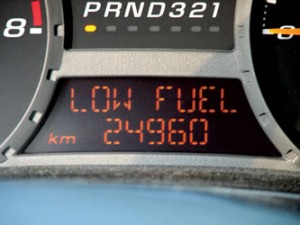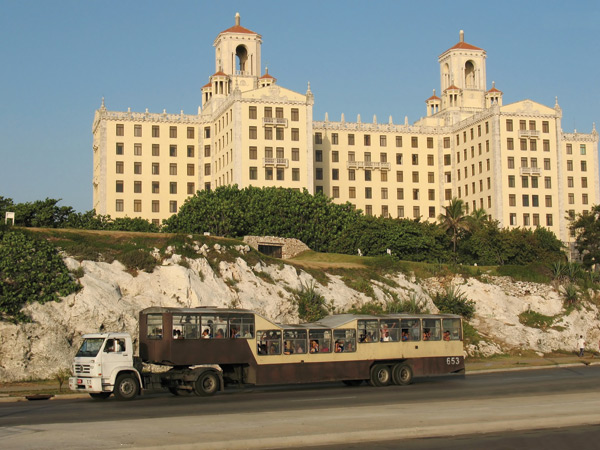Over a Barrel
How high oil prices are affecting life In The Hills.

These days, across Headwaters everyone’s starting to hear the global “low fuel” bell, and just like in my car, it’s ringing faster and more urgently than ever before. Photo by Jeff Rollings.
I’m planning a little trip to Canadian Tire. Not for the usual garden centre goodies or a great deal on paint. This time it’s to buy a locking gas cap for my car.
A work-at-home type, I don’t drive much. Nonetheless, it feels like I just put twenty dollars in and the next day it’s “Low fuel! Low fuel!” – the chirpy little dinger chiming faster and more urgently, for some strange reason, than if it were a mere open door or undone seatbelt.
These days, across Headwaters everyone’s starting to hear the global “low fuel” bell, and just like in my car, it’s ringing faster and more urgently than ever before.
Also like the car, left unattended it threatens to bring the well-being of our community to a sputtering halt.
Of course, I realize that it’s unlikely anyone is stealing my gas. The theft, if there was one, took place at the pump. And the locking gas cap is really more about my own gathering paranoia, as I watch the cost of getting around – and keeping my house warm – explode through the roof.
Particularly when it comes to transportation, rural folk get a raw deal. Compared to our urban counterparts, we must drive greater distances for not only work, but also groceries, entertainment, medical care and, let’s not forget, gas. One recent US study estimated rural dwellers drive an average of 5,000 kilometres more per year. Rural households are also more likely to have less fuel-efficient vehicles, like SUVs and pickups. For many, telecommuting, carpooling and public transit simply aren’t options. Heating your country home can be more expensive too, because isolated buildings are more exposed to the elements than city houses, built cheek-by-jowl with their neighbours.
Here at home, it won’t come as news to anyone that the effects of skyrocketing energy prices are starting to appear everywhere.

Commuter Rick Gallant traded in his comfortable Oldsmobile for a more fuel-effi cient car, but as he points out to sympathetic gas station owner Hardip Darar, even that is now becoming costly. “Most people understand that I don’t make any more when the price goes up,” says Darar. “People will comment that the price is outrageous, of course, but they don’t blame me.” Photo by Pete Paterson.
Let’s start where the nozzle hits the gas tank. Hardip Darar, owner of the Shell gas station in downtown Orangeville, says he hasn’t seen very much of “gas and dash,” where people fill up and drive away without paying. “Most people understand that I don’t make any more when the price goes up,” he says. “And I pay the same price as everybody else when I fill up. People will comment that the price is outrageous, of course, but they don’t blame me.”
On this afternoon, Darar’s usually busy station is quiet. “People are paying a lot more attention now,” he says. “Today the price of oil dropped six dollars a barrel. Anyone who’s heard that on the radio knows that tomorrow the price at the pumps will drop, so they’re all waiting.” Sure enough, the next day the price per litre had dropped by a dime.
Rick Gallant is one of those guys who is out of the house by 4:50 every morning. He commutes from Orangeville to Bombardier in Downsview, has done for twelve years, and racks up about 50,000 kilometres annually.
At one time he was willing to absorb some extra cost for the benefit of a more comfortable ride. These days, however, the big gas-guzzler is gone, replaced by a Japanese import. “Four years ago,” he says, “I realized that the Oldsmobile was costing $110 a week for gas. I got a Corolla and overnight it went to $40.”
Now, even the Corolla is getting expensive, with a regular five-day workweek costing Gallant about seventy dollars for fuel. “My wages haven’t increased seventy-five per cent in the last four years,” he says.
What will he do if the price keeps increasing? “I’ll start carpooling if I have to, but it’s really inconvenient. I leave so early in the morning as it is, and only so many people are going to Downsview.”
Rick also feels the spiralling cost adds to the threat of hot-tempered drivers. “I’ve seen an increase in aggressiveness on the highway.” And, considering how many hours commuters spend in their cars, he adds “You can’t put a price on the stress.”
On a more positive note, however, there may also be safety benefits. “In the last few months, people are driving a lot slower on Highway 10,” he says. “It used to be that even if you went 110, everybody would fly past you. Now I drive eighty-five, and I’m surprised if I get passed by four cars. What the government tried to do with radar has been achieved by high gas prices.”
And of course, Gallant’s not only getting nailed when he fills up at Hardip Darar’s station. There’s also the not-so-small detail of keeping his house warm. In some respects, he gets off lucky there – his house is relatively new, fairly well-insulated, and a reasonable size. Still, he says, “When I moved here fifteen years ago, my highest natural gas bill was $85. Last winter the highest one was $285.” So, like many of us, he says he’s “doing a bit at a time,” having replaced windows and added insulation so far.
As Roy Bryan, of Bryan’s Fuel in Orangeville points out, Gallant’s going to see that home heating bill take another breath-taking leap this winter. “People don’t realize that the cost of home heating has also gone up over the summer, while no one is using it. They’re in for a shock come winter.” With more than 4,000 customers buying home heating fuel, Bryan’s is also on the front line when it comes to paying the bill.
Are the high prices causing people to be unable to pay? “I was surprised it was okay last year,” Bryan says. “But I’m worried about this year. It’s always the marginalized who struggle, and of course they’re the ones who can’t afford to upgrade.”
So what can you do? Start breaking up grandma’s antiques to use as firewood?
Don Roper, at Don’s Heating and Air Conditioning in Orangeville, feels his customers are focusing on the practical. “I hate to say it, but rising energy prices have been good for my business. Usually in the summer like this, 80 per cent of our business is central air-conditioning systems. This summer has been cooler, so our sales of air-conditioning systems are down. However, overall our sales are up.”
This fortuitous turn of events is thanks in large part to the federal government’s ecoENERGY program, which provides grants to residential property owners for energy efficiency retrofits. The province then matches these grants. “People are taking advantage of all the rebates and getting high efficiency furnaces and air conditioners.”
The program covers a wide assortment of common household energy-efficiency items, including not only replacement of heating and cooling systems (even wood stoves), but also water heaters, windows and doors, insulation, air-sealing measures, and water-conserving toilets. The amount of the rebate ranges from $60 for a window or door, up to $1,000 for a high-efficiency gas furnace, and $7,000 towards a geothermal heating and cooling system.
A homeowner’s first step is to contact a certified inspector, who, for a fee of $325, will perform an energy audit on your house and provide a report outlining where the greatest savings can be made. $150 of that amount is refundable from the provincial government, and in any event, as Roper points out, “Even if you don’t do the major work they recommend, most people will get the fee back in the first year, just from doing the little things they suggest, like filling cracks and holes.”
Of course, the bigger things have a bigger impact. A more efficient furnace, for example, not only saves on fuel, but, says Roper, “People don’t realize that a typical older gas or oil furnace will use $350 to $400 a year just in hydro. With these new efficient fan motors, that’s reduced to less than $100. Replacing an old central air-conditioning unit with a new one will cut hydro consumption by half.”
More information about the ecoENERGY program is available by visiting www.ecoaction.gc.ca and following the links to ecoENERGY Retrofit.
For residents of Caledon, there is also the PowerHouse program, operated by Enersource Hydro Mississauga, Hydro One Networks and Hydro One Brampton Networks. This pilot program offers zero-interest loans and rebates on renewable technologies, including geothermal, solar and wind. PowerHouse projects must be complete by February 15, 2009.
Do these rebate programs really make much difference in the big picture? Apparently so. A 2007 program called the Cool Savings Rebate issued a total of 124,965 rebates, for a total of $23.9 million. The result? The equivalent of 4,000 homes being removed from the grid – about 45 per cent higher than targetted.
So let’s say your house is sealed up as tight as can be and bursting with insulation, and your furnace so efficient that David Suzuki regularly brings friends by to show it off. Or not. Maybe, as it is for many, the reality is that all these great rebate programs are out of your reach, next month’s mortgage or rent payment a more pressing concern.
What other options are there?
One method of slashing your heating bill is space heating, or simply not heating parts of the house you aren’t using. Craig Thompson at Hearth and Leisure in Primrose knows his space-heating systems. Hearth and Leisure has been selling woodstoves, fireplace inserts and other space-heating products since 1976. He says “interest has been huge” as people seek ways to avoid soaring home-heating costs.
The big seller at their shop these days is in fact not woodstoves at all, but rather pellet stoves. Significantly improved since their introduction in the 1980s, pellet stoves burn fuel usually made from waste wood products, though some can also burn corn, grain, and even cherry pits. Depending on circumstances, many units are capable of heating an entire home, and typically require less work than a woodstove, only needing to be refuelled twice a day. They also require a less costly chimney system than traditional woodstoves.
What happened to the airtight woodstove and fireplace insert craze? “We sold so many after Hurricane Katrina,” Thompson says, “that I think in this area we saturated the market. Now, most people who can have one already do.” That brings him to another point. “In the last few decades, very little new housing has been built to accommodate wood heating. Everyone is totally dependent on gas or oil. What will they do if it just becomes too expensive to use?”
A few kilometres south at Caledon Fireplace Ltd., the market is a little different. After twenty years in business, owner Roberta Bennett says “for us it’s ‘will it be a big gas year or a big wood year?’” Last year, their sales were split about 40 per cent gas to 60 per cent wood. A lot of their installations are in new, custom construction, and Bennett says “often these places will have three fireplaces. People usually want at least one of them to be wood burning.”
The selection at Caledon Fireplace demonstrates the wide range of choices available, and they are also gearing up for what is expected to be a big business pickup this fall. “It’s typical for people to wait until September.” Bennett says. “There’s that fall feeling that happens, and suddenly everyone is thinking about it.” She also makes a plea, both for her own sanity and for the benefit of her customers: “Please don’t wait. It’s gonna get crazy.”
Needless to say, commuters and people buying Roberta Bennett’s woodstoves to reduce their home heating bills aren’t the only ones in our community experiencing the effects of rising energy costs. Trucking has been hit with a double whammy. Not only has the price gone up overall, but diesel, which has traditionally been cheaper than gasoline, has risen even further and now costs more per litre than gas. Education will see an impact, as a thirty to fifty per cent increase in fuel costs will significantly increase the cost of busing, taking away from an already strapped education budget. In some communities, there are reports of seniors avoiding their medical appointments because of the cost of frequent trips – something to monitor if you have elderly family members.
The agricultural sector is perhaps hardest hit of all. From the tractors and equipment that till, plant and harvest, to food-processing machinery, to shipping from the farm to the table, many aspects of food are dependent on energy. The results of dramatic increases in food prices are already being felt around the world.
Perhaps surprisingly, not all the effects of expensive energy are bad. Sandy Ball and Patrick Bogert are Erin real estate agents who sell mostly rural properties throughout Headwaters for Chestnut Park Realty. In their view, rising energy prices have largely been good for the local real estate market – especially weekend places. “We’re seeing people who at one time would have gone to Muskoka,” Bogert says. “But now, they consider both the cost and the traffic, and look closer to home.”
But are full-time residents moving back to the city because of the commuting cost? “You’d likely find that with more urban properties,” says Bogert. “People who moved up from Brampton or Mississauga to Orangeville and have to go back every day for work.” Instead, owners of higher-end rural properties are rearranging their professional lives. “Many of our clients work from home now,” says Ball. “They may go into the city one or two days a week.”
Like real estate, tourism is another sector that may actually benefit from escalating energy prices. While the number of travellers from afar may go down, Headwaters close proximity to the heavily populated GTA could make it an attractive destination as people look for recreation and vacation opportunities closer to home.
Alton’s Millcroft Inn was quick to see the potential marketing opportunity. A survey about rising gas prices posted on the Millcroft’s website drew nearly 900 responses, with the majority saying that prices would influence their vacation choice. In response the Millcroft offered a “gasoline rebate” of forty dollars to guests who booked two-night “getaway packages.”
Still, the longer-term impact on the wider community remains uncertain. The demand for large homes may soften as heating costs soar. Traditionally, people have located in Orangeville and commuted because their housing dollar went further, but those savings are being eroded by the cost of the commute.
Metrolinx, a regional authority created by the province of Ontario, is slated to release a Draft Long Range Plan for Transportation in the fall of 2008. The plan will be GTA-focussed, and although the study area includes Caledon, it does not include Dufferin.
Claimed to be the third part of the McGuinty government’s growth strategy, along with the Greenbelt and Places to Grow legislation, the plan may include billions of spending on public transit. However, it is also expected to propose controversial measures such as road tolls, potentially placing yet another burden on Headwaters commuters.
American social critic and author James Howard Kunstler has written extensively on the world after “peak oil.” His bleak vision of the future, where the car-dependent suburbs have been abandoned to slum housing and rural residents are surviving winter on home-grown turnips from their root cellar, is in stark contrast to the Headwaters we know today.
In the meantime, as the sun rises over Caledon Mountain, Rick Gallant and his shrinking car will keep making their way down Highway 10.
Slowly.
_________
When the Pumps Ran Dry in Cuba

Also horses, such as those outside the capital building in Havana, have been put back into service as a common means of transportation in Cuba. Photo by Jeff Rollings.
Following the fall of the Soviet Union in 1991, oil imports to Cuba dropped from between thirteen and fourteen million tons a year to only four million. As a result, gross domestic product dropped by a third, the average calorie intake also dropped by a third, and problems of malnutrition and depression followed. By 1994, the average Cuban had lost twenty pounds in weight. Because of US trade sanctions, the country was ineligible to receive food aid.
Lessons learned from the Cuban experience may have application here, if, as several economists predict, oil hits $200 a barrel in the not-too-distant future.
Oil shortages affected Cuba quickly. This meant that the national government had little control over what was happening in the country. It delegated responsibility to local governments, and this in turn led to the development of grassroots movements.
Agriculture experienced perhaps the most dramatic change. Abandoning fuel-consuming tractors and mechanized equipment, oxen were brought back into service, and many more people – as many as 15 to 25 per cent of the population – became engaged in the production of food. A migration from the cities back to the countryside took place, and farmers’ status in the community rose dramatically – they now earn more than engineers and scientists.
The practice of urban agriculture also exploded, and the country is now a world leader in this movement, with more than 35,000 hectares of urban land (and rooftops) in use for intensive food production. Eighty-five per cent of Cuba’s food is now organic, avoiding the need for fertilizer.
Although it was a painful process, overall these changes have resulted in a secure Cuban food system with little reliance on pesticide, fertilizer or machinery. What’s more, there has also been a positive impact on human health as diet improvements resulted from eating fresh, locally-grown food.
Similarly, transportation underwent a transformation. The government imported bicycles. Public transit was expanded, albeit crudely, with the introduction of two-humped “camel” buses – tractor-trailers that can carry many more people than conventional buses. Government vehicles were required to pick up hitchhikers, of which there are many. People also went back to using horses and mules as a way to get around.
Housing was also affected, due to the cost and difficulty of providing materials. As a result, people live in small houses, in large family groups. Rural schools are built with solar panels, and are not connected to the grid. And, although education continues to be provided free by the government, the system has been decentralized, to reduce the need for travel and busing.
Related Stories

Geothermal. Earth Energy.
Sep 15, 2008 | | Back IssuesCLEAN, RENEWABLE AND FREE. Call it what you like, with the support of large grants and rebates for installation, Headwaters residents are pulling heat from the ground.

Soul of the Home
Sep 15, 2008 | | EnvironmentIn Finland, masonry heaters are known as “heart of the home,” and in Russia it’s “soul of the home,” reflecting the importance they have in people’s lives.









